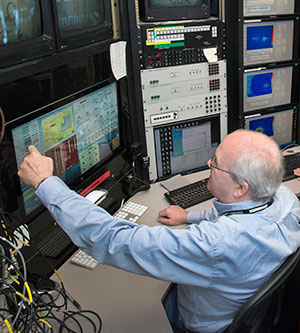- Home
- Capabilities
- Science Highlights
- Operations
- Publications
-
ES&H
- Experiment Start-up
- Laser Safety
Collider-Accelerator Dept.
- C-AD ES&H Resources
- Staff
- Users' Place
- Apply for Access
Applying for Facility Access
The Accelerator Test Facility serves a broad community of researchers from national and international laboratories, universities and businesses that use accelerators and lasers. Access is provided for fundamental accelerator science, accelerator technology development, and for users who wish to exploit the accelerator capabilities that are available at the ATF. The facility is sponsored by the U.S. Department of Energy Office of High-Energy Physics under the Accelerator Stewardship program and provides free beam access to qualified researchers performing non-proprietary work whose results will be public. Full cost recovery is in effect for proprietary research (as well as for raw materials and manufacturing support provided by the facility).
Experimental Options
The ATF presently offers facilities in BNL Building 820 for experiments utilizing its high brightness electron beam and various laser systems, including a TW-class CO2 laser system. In 2016, an Ultrafast Electron Diffraction (UED) facility residing in BNL Building 912 has been added to the ATF portfolio. This facility aims to further develop the accelerator capabilities to support electron diffraction studies as well as experiments utilizing this technique. A summary of the capabilities available to the ATF Users is available here.
Application Process
Requests for access to the ATF are made through the Proposal Allocation, Safety, and Scheduling (PASS) System, which is administered by the BNL GUV Center. When entering a proposal, requests for ATF beam time can be made as an ATF Proprietary or Non-Proprietary User for access to the following capabilities in Building 820:
- Electron Beam
- Laser (LWIR and/or NIR)
- Electron Beam and Laser (LWIR and/or NIR)
Applications for access to the Accelerator Test Facility are evaluated by the ATF Program Advisory Committee (APAC), which meets annually. Apply for access by selecting the create new proposal option in the PASS proposal submission system, making sure to attach a scientific case complete with references (Note: a Google account is required for PASS access). We ask that users attach the 5-page ATF proposal document (.docx) to their PASS application. ATF proposal submission is now administered by the GUV center, please address any questions about the submission process to Mary Jane Ilardi.
Potential users are encouraged to contact the relevant capability coordinator to discuss details such as the required electron beam parameters, laser parameters, beam line space allocation, and for help in estimating the required beam time.
- Electron beam coordinator, William Li
- CO2 LWIR laser coordinator, Igor Pogorelsky
- Near-IR laser coordinator, Marcus Babzien
For help with labor requirements and hazard assessments, please contact the ATF ESH coordinator, Karl Kusche.
Three categories of User Access are provided for the use of the ATF:
Regular Access: In this case, new proposals are submitted as part of the annual call for proposals and are scheduled for oral presentation at the APAC and Users Meeting. Approval for Regular Access is made by the ATF Director based on recommendations made by the APAC. Regular Access to the ATF will be scheduled by the ATF Operations Coordinator based on the time request that is described in the proposal. Beam Time proposals are presently being accepted for 3 years duration for electron beam, LWIR, and NIR capabilities while proposals utilizing the UED facility are being accepted for up to 2 years duration.
Fast Track Access: In exceptional situations of justified urgency, a new user experiment may be considered for Fast Track Access approval before the time of the next APAC meeting. Fast Track Access is approved by the ATF Director in consultation with the Associate Laboratory Director. Fast Track Access is granted only until the next APAC meeting; at that time, the proposal must be resubmitted for full approval under the Regular Access process.
Feasibility Study Access: This access is aimed at checking if the requirements of an experiment match the capabilities of the ATF in order to support a proposal for a regular experiment. A Feasibility Study can be approved by the ATF Director for a limited period, not to exceed one year, with the understanding that such access receives lower priority than user experiments approved for Regular or Fast Track Access as well as facility maintenance activities.
Procedures for Approved Experiments
Approved users must ensure that a research agreement is in place between their institution and Brookhaven National Laboratory; to confirm agreement status or to put a new agreement in place, please contact Mary Jane Ilardi.
As soon as your experiment has been approved you should see here about scheduling beam time and how to apply for site access.
Annual reporting is mandated by DOE for users of Office of Science User Facilities. This reporting takes place in the form of an oral presentation at the annual APAC meeting by the Principle Investigator or other registered member of the experimental team. A written report summarizing each year’s progress must also be submitted. All experiments are required to submit a written report upon completion of the experiment.





